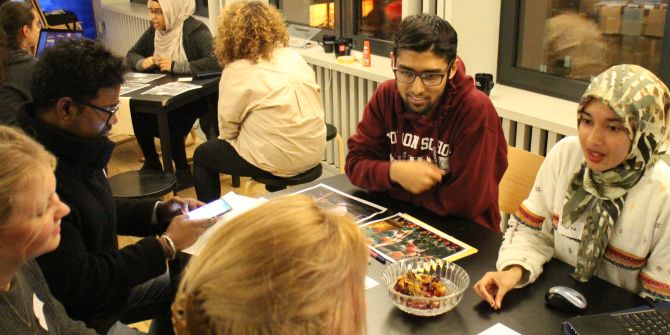LSE Visiting Fellow Helena Chmielewska-Szlajfer recounts her visit to Holy Land Experience in Orlando, Florida. Here, Helena considers the strangeness of Biblical stories being presented as spectacle and recalls the spiritual authenticity of the visitors’ responses.

Located on fifteen acres of land in Orlando, Florida, a city famous for its theme parks, Holy Land Experience calls itself a ‘living, Biblical history museum’. Owned by Trinity Broadcasting Network, the largest American Christian media corporation, it is indeed a scaled down, Disneyland version of the Holy Land from the time of Christ. Situated next to a highway, it is surrounded by a plaster wall which resembles an ancient fortress; the entrance gate is inspired by the Lions’ Gate in Jerusalem.
Once inside, visitors find themselves in a little faux-ancient-Middle-Eastern town carved in plastic and plaster imitating stone, decorated with Roman mouldings and vases, fake grass, and plants on the concrete ground. The visual appearance of Holy Land Experience is not only useful in attracting potential visitors, as it also makes interpretations of the Bible more familiar through using the tools offered by the rules of entertainment: enchantment, surprise, spiritual emotionality, sensory experience, and grandeur.
The day at Holy Land Experience begins at 10am and is organised around “performances”, thirty-minute stagings of New Testament events and contemporary adaptations of Biblical parables. These shows seamlessly blend old stories and period-like props with contemporary contexts; the most famous, and violent, is the Passion of Christ, held twice a day at noon and 5pm, the latter concluding with a Broadway-style, confetti-bursting resurrection. It is the final performance before the park closes at 6pm.
While most of the performances are Biblical adaptations, one of the more popular shows, “Celebrate America”, is focused on idealised small-town life and is a perfect example of how Holy Land Experience visitors are turned into active participants. In this comedy about preparations for a local celebration, a long-gone son returns home from Iraq just as the party is finally supposed to start. Seamlessly blending the story performed on the stage with the watching audience, the actors ask people to stand up from their seats if they have family members who have served in the army. Some of the viewers rise, and the actors come over to congratulate them. While this is happening, two flat television screens on either sides of the stage show old black-and-white recordings of air bombings.
Through this mix of fiction and reality, acting and earnestness, the audience members—and their individual experiences—become part of the performance. What’s more, the conversations between the viewers and the actors continue once the show is over; people share their experiences from the army and thank each other ‘for their service to the nation’. This type of interaction between actors and viewers, which transcends the fictitiousness of the stagings, can be seen many times throughout the day.
During “The Four Women Who Loved Jesus”, people in the audience cry and enthusiastically applaud the moral transformation of the Biblical characters, made possible thanks to God. The viewers’ passionate reaction is crucial in making the performance a communal experience, and not “just” a show to be watched. The actors in the performance emphasise that faith in God provides answers to all questions. Without faith, one is hopelessly lost in desires, unable to make moral decisions. At Holy Land Experience, divine grace is presented as a choice not only obvious but pragmatic: why would one not choose clear answers to life? Spirituality is saved from ambiguity.
Holy Land Experience includes a number of attractions, including the Scriptorium which, according to the flyer, holds the world’s fourth-largest collection of Bibles. There is also a replica of the cave where Christ was born. This opens to the Last Supper room on the other side, where several performances of the Holy Mass are held during the day with the visitors’ active participation (according to the poster outside, only believers in God, supposedly Christian, are allowed to come in). In another building, named Christus Gardens, an exhibition of the life of Christ ends with the resurrection, which includes a life-size plaster white horse clad in a sparkly silver blanket and bridle, more fairy tale than New Testament.
What is even more striking is that instead of the typical long, suffering face of Christ, at Holy Land Experience the images of the Son of God bear strong masculine features based on those of the actor who performs the part. The suffering Jesus is replaced by the image of a powerful superhero on a white horse, an allusion to an American-type brave cowboy rather than the Christian Good Shepherd.
When the visitors want to engage in less religious consumption, they can do so in two big gift shops, a cafeteria, and a coffee shop with packaged goods imported from Israel that can bring visitors closer to the original Holy Land. ‘This is the closest you can get’, explained the lady behind the counter.
All these attractions available at the theme park lead to the question of what “experience of the Holy Land” this manufactured space actually offers. On the one hand, it is hyperrealistic and clearly artificial, yet on the other hand the overload of fabricated details such as painted marble veins and fake camel footprints creates convincing shortcuts for the visitors to immerse themselves in what they describe as a spiritual experience. (‘It’s very moving’, is a comment I heard from several visitors.) Moreover, people’s impassioned reactions to the shows suggest that there may be something cathartic about the experience of witnessing, of “re-experiencing”, Biblical events, even if they are staged. In the name of faith, Holy Land Experience attempts to transcend the boundaries of time, space, and materiality, disregarding historical contexts and opting for a fundamentally contemporary, eclectic, pop-cultural, and entertainment-laced mix.
At Holy Land Experience, the interpretation of the New Testament is a time-less blend of physical (replicas of places, products from Israel), Biblical (staging stories from the New Testament), historical (the collection of Bibles at the Scriptorium), fable (the white horse in Christus Gardens), and contemporary entertainment (musical-like performances, Christ’s portrayal as a superhero). Holy Land Experience creates a substitute not just for the Holy Land but also for theme-park entertainment. A substitute, in that it offers neither the actual space, nor the carefree fun.
Locating a place that claims to offer a spiritual Christian experience inside a major theme park area, while applying the colourful, plastic theme-park “look”, is a deliberate choice. Although the visitors might go to Sea World tomorrow, they come to Holy Land Experience to learn about Jerusalem in the time of Christ, and to practice faith in an entertaining, leisurely setting. However fabricated the space, it provides aesthetic and intellectual shortcuts which, as the appreciative viewers emphasise, lead to a spiritual experience they find authentic.
This post is based on the article “Authentic experience” and Manufactured Entertainment: Holy Land Experience Religious Theme Park, published in the Polish Sociological Review, 200(4), pp. 545-588 http://polish-sociological-review.eu/uploads/2017/12/PSR200-10.pdf
About the author
 Helena Chmielewska-Szlajfer is a sociologist, Assistant Professor at Kozminski University Department of Management in Networked and Digital Societies and Visiting Fellow at LSE Department of Media & Communications. Her research is focused on politics and civic engagement in online media and everyday culture after 1989. Her current research focuses on the politicisation of online tabloids in the US, UK, and Poland. Author of Marxism and Sociology: A Selection of Writings by Kazimierz Kelles-Krauz (Brill, 2018) and Reshaping Poland’s Community after Communism: Ordinary Celebrations (Palgrave, 2018, forthcoming). Twitter: @HChSz
Helena Chmielewska-Szlajfer is a sociologist, Assistant Professor at Kozminski University Department of Management in Networked and Digital Societies and Visiting Fellow at LSE Department of Media & Communications. Her research is focused on politics and civic engagement in online media and everyday culture after 1989. Her current research focuses on the politicisation of online tabloids in the US, UK, and Poland. Author of Marxism and Sociology: A Selection of Writings by Kazimierz Kelles-Krauz (Brill, 2018) and Reshaping Poland’s Community after Communism: Ordinary Celebrations (Palgrave, 2018, forthcoming). Twitter: @HChSz
Note: This piece gives the views of the author, and not the position of the LSE Religion and Global Society blog, nor of the London School of Economics.






1 Comments